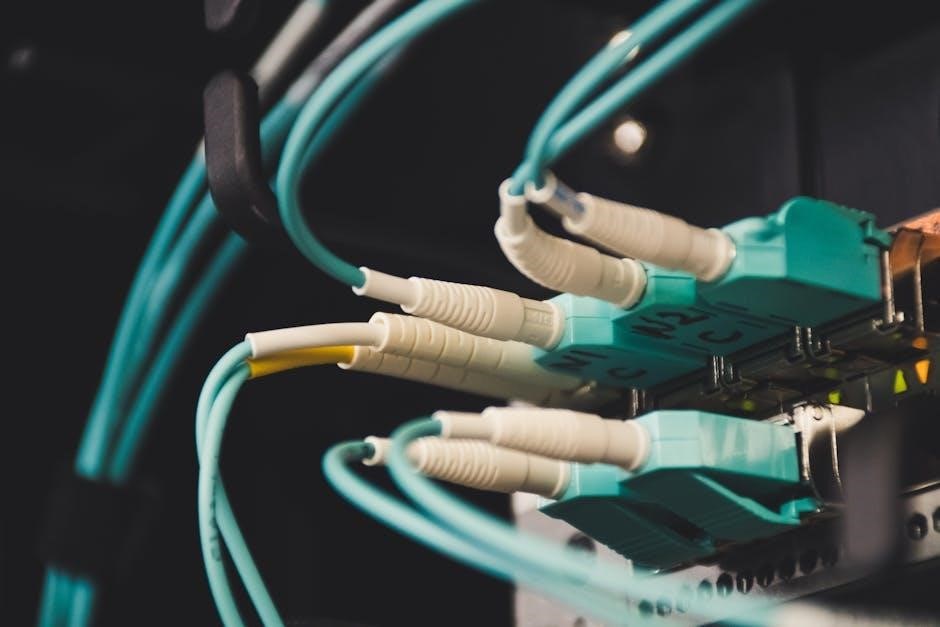Ethernet OAM (Operations, Administration, and Maintenance) is a set of protocols and tools for monitoring, troubleshooting, and maintaining Ethernet networks, ensuring reliability and performance;
1.1 Overview of Ethernet OAM
Ethernet OAM (Operations, Administration, and Maintenance) is a set of protocols and tools designed to monitor, troubleshoot, and maintain Ethernet networks. It provides functions like fault detection, performance monitoring, and security management, ensuring network reliability and optimal performance. Ethernet OAM supports various standards, including CFM (Connectivity Fault Management) and ITU Y.1731, enabling efficient link testing and diagnostics. It is widely used in both LAN and WAN environments to ensure smooth network operations and quick fault resolution, making it essential for modern network management.
1.2 Importance of Ethernet OAM in Network Management
Ethernet OAM is crucial for maintaining high network availability by enabling proactive fault detection, performance monitoring, and security management. It allows network operators to quickly diagnose and resolve connectivity issues, ensuring minimal downtime. Its tools and protocols are essential for optimizing network performance and reliability, making it indispensable in both small and large-scale network infrastructures.

Core Concepts of Ethernet OAM
Ethernet OAM’s core concepts include maintenance points, fault detection, and performance monitoring, ensuring network reliability and efficiency through standardized tools and protocols.
2.1 Definition and Scope of Ethernet OAM
Ethernet OAM (Operations, Administration, and Maintenance) is a set of protocols and tools designed to monitor and troubleshoot Ethernet networks. It provides mechanisms for fault detection, performance monitoring, and diagnostics, ensuring network reliability and efficiency. The scope of Ethernet OAM includes managing and maintaining Ethernet services in both local and wide-area networks. It is standardized by organizations like IEEE (802.1ag) and ITU (Y.1731), enabling consistent network management across diverse environments. Ethernet OAM is essential for maintaining service quality and reducing operational costs in modern networking infrastructures.
2.2 Key Functions of Ethernet OAM
Ethernet OAM’s key functions include fault detection, performance monitoring, and diagnostics. It identifies issues like link failures and misconfigurations, measures metrics such as delay and jitter, and uses tools like loopback testing for troubleshooting. These functions enhance network reliability, reduce downtime, and ensure optimal performance. By providing real-time insights, Ethernet OAM helps maintain high service quality, crucial for both carrier and enterprise networks.
2.3 Maintenance Points in Ethernet OAM (MEPs and MIPs)
Maintenance Points (MEPs and MIPs) are critical components in Ethernet OAM. MEPs (Maintenance End Points) are located at the boundaries of a maintenance domain, responsible for generating and responding to OAM messages. MIPs (Maintenance Intermediate Points) are intermediate devices that forward OAM messages and detect faults. Together, they enable fault detection, isolation, and performance monitoring. MEPs and MIPs work together to ensure accurate fault identification and maintenance operations within the network, enhancing overall reliability and management efficiency.

Ethernet OAM Protocols and Standards
Ethernet OAM relies on protocols like CFM (Connectivity Fault Management) and standards such as IEEE 802.1ag and ITU Y.1731. These ensure performance monitoring and fault detection.
3.1 Overview of CFM (Connectivity Fault Management)
Connectivity Fault Management (CFM) is a critical protocol in Ethernet OAM, defined by the IEEE 802.1ag standard. It enables proactive monitoring and troubleshooting of network connectivity issues. CFM uses maintenance domains and associations to define the scope of fault management. It employs tools like Linktrace and Loopback to detect and isolate faults, ensuring quick identification of issues in the network. This protocol is essential for maintaining network reliability and reducing downtime in Ethernet-based environments.
3.2 ITU Y.1731 and IEEE 802.1ag Standards
ITU Y.1731 and IEEE 802.1ag are foundational standards for Ethernet OAM. Y.1731 focuses on performance monitoring, enabling precise measurement of frame loss, delay, and jitter. It supports advanced traffic management and service-level agreements. IEEE 802.1ag complements this by defining CFM, which identifies and isolates connectivity faults. Together, these standards ensure robust network reliability, scalability, and efficient fault management in Ethernet environments, catering to both carrier-grade and enterprise networks.
3.3 MEF 30.1 Specifications for Ethernet OAM
MEF 30.1 defines requirements for Ethernet OAM in Carrier Ethernet networks. It specifies tools for service assurance, including fault management and performance monitoring. MEF 30.1 aligns with ITU Y.1731, extending OAM capabilities for multi-provider networks. It enables service providers to deliver reliable, high-performance services by ensuring consistency in OAM implementations. This standard is critical for maintaining Service Level Agreements (SLAs) and ensuring seamless communication across Ethernet networks.

Fault Management in Ethernet OAM
Fault management in Ethernet OAM involves detecting, isolating, and resolving issues to ensure network reliability. It employs tools like loopback tests and link monitoring to maintain service quality and minimize downtime effectively.
4.1 Fault Detection and Isolation Techniques
Fault detection and isolation in Ethernet OAM are crucial for maintaining network reliability. Techniques involve using CFM (Connectivity Fault Management) to send periodic messages and analyze responses for issues like link failure or congestion. Maintenance points such as MEPs and MIPs monitor traffic and alert when faults occur. These mechanisms help pinpoint faults, allowing targeted troubleshooting and minimizing network downtime. Standardized protocols ensure interoperability across devices, enhancing overall network performance and service quality.
4.2 Link-Fault Management and Recovery
Link-fault management in Ethernet OAM ensures quick identification and resolution of connection issues. Techniques include monitoring link status, detecting signal loss, and identifying packet errors. Recovery mechanisms, such as automatic protection switching, reroute traffic to maintain service continuity. Redundancy and backup paths are often used to minimize downtime. These strategies ensure network reliability, reduce operational costs, and improve end-user experience by restoring services swiftly. Effective link-fault management is essential for maintaining high availability in Ethernet networks.
4.3 Using LBM and LBR for Fault Detection
Linktrace Bootstrap Message (LBM) and Linktrace Reply (LBR) are critical tools in Ethernet OAM for fault detection. LBM initiates a trace request to identify the path a frame takes through the network, while LBR responds with detailed information about the frame’s journey. These messages help pinpoint faults by revealing the exact location of failures, such as defective links or switches. This method enhances troubleshooting efficiency, enabling quick isolation and resolution of issues in complex Ethernet networks.

Performance Monitoring with Ethernet OAM
Ethernet OAM enables precise performance monitoring by measuring frame loss, delay, and jitter. It collects traffic statistics and uses tools like CFM to ensure optimal network operation and QoS.
5.1 Measuring Frame Loss, Delay, and Jitter
Ethernet OAM provides robust tools to measure frame loss, delay, and jitter, ensuring network performance monitoring. Frame loss is tracked by counting dropped frames, while delay and jitter are measured using timestamped packets. These metrics are critical for maintaining QoS, especially in real-time applications. OAM protocols like CFM and Y.1731 enable precise measurements, helping identify bottlenecks and ensure reliable data delivery. Accurate monitoring of these parameters allows network administrators to optimize performance and troubleshoot issues proactively, ensuring a seamless user experience.
5.2 Traffic Statistics Collection and Analysis
Traffic statistics collection and analysis are vital for understanding network behavior and optimizing performance. Ethernet OAM tools gather data on parameters like bandwidth usage, packet loss, and error rates. This data helps identify trends, detect anomalies, and pinpoint performance bottlenecks. By analyzing traffic patterns, administrators can allocate resources effectively and ensure reliable service delivery. Advanced OAM protocols enable detailed insights, facilitating proactive network management and enhancing overall efficiency. Regular analysis of traffic statistics is essential for maintaining high network performance and user satisfaction.
5.3 Performance Monitoring Tools and Methods
Ethernet OAM offers robust tools and methods for performance monitoring, ensuring network reliability and efficiency. Tools like CFM, Y.1731, and TWAMP enable precise measurement of delay, jitter, and frame loss. These methods utilize synthetic traffic testing and passive monitoring to detect performance degradation. Threshold-based alerts and automated reporting simplify troubleshooting. By integrating these tools into network management systems, administrators can maintain optimal performance, ensure SLA compliance, and deliver high-quality services. Regular monitoring helps identify trends and address issues before they impact end-users.

Security Management in Ethernet OAM
Ethernet OAM incorporates essential security features to protect networks from unauthorized access and cyber threats, ensuring data integrity and confidentiality.
6.1 Security Features of Ethernet OAM
Ethernet OAM includes robust security features such as authentication, encryption, and access control to safeguard network integrity. It prevents unauthorized access and ensures data confidentiality. Secure communication channels protect OAM messages from tampering and eavesdropping. Role-based access controls restrict OAM functionality to authorized personnel, minimizing potential breaches. Additionally, Ethernet OAM supports secure session management and audit logging to monitor and respond to security incidents effectively.
6.2 Protecting Ethernet Networks from Attacks
Ethernet OAM employs mechanisms to protect networks from malicious attacks, ensuring reliability and security. It uses encryption to safeguard data integrity and secure authentication methods to prevent unauthorized access. Access control lists (ACLs) and rate limiting help mitigate denial-of-service (DoS) and distributed denial-of-service (DDoS) attacks. Additionally, OAM tools monitor network behavior, enabling early detection of anomalies and swift isolation of compromised segments. These features collectively enhance network resilience against potential threats and vulnerabilities.
6.3 Authentication and Authorization in OAM
Ethernet OAM incorporates robust authentication and authorization mechanisms to ensure secure network management. Techniques such as 802.1X port-based authentication and SNMPv3 encryption protect access to OAM functions. Role-based access control (RBAC) restricts privileges, allowing only authorized personnel to execute critical tasks. These features prevent unauthorized users from manipulating OAM data or disrupting network operations. By enforcing strict access controls, Ethernet OAM maintains the integrity and security of network management processes, safeguarding sensitive information and ensuring compliance with security protocols.

Diagnostic Tools and Techniques
Ethernet OAM provides essential diagnostic tools to identify and resolve network issues efficiently. Techniques like Loopback, Ping, and Traceroute enable comprehensive fault detection and troubleshooting.
7.1 Loopback Mode for Link Testing
Loopback Mode is a critical diagnostic tool in Ethernet OAM for testing link connectivity. It enables Maintenance End Points (MEPs) to send test frames to Maintenance Intermediate Points (MIPs), verifying the integrity of a network segment. This mode helps identify faults by echoing frames back to the source, ensuring accurate fault isolation. Loopback testing is essential for real-time monitoring and troubleshooting, providing immediate insights into link performance and reliability.
7.2 Using Ping and Traceroute for Fault Diagnosis
Ping and Traceroute are essential tools for fault diagnosis in Ethernet OAM, enabling network administrators to identify connectivity issues. Ping verifies reachability by sending ICMP echo requests, while Traceroute maps the path to a destination, highlighting bottlenecks or failures. These tools integrate with OAM protocols to provide real-time insights, aiding in quick fault isolation and resolution. They are invaluable for troubleshooting, ensuring network reliability and performance by pinpointing issues accurately.
7.3 Advanced Diagnostic Methods in OAM
Advanced diagnostic methods in OAM involve sophisticated tools and techniques to detect and resolve complex network issues. Synthetic traffic generation allows administrators to simulate real-world traffic for precise fault detection. Deep packet inspection enables detailed analysis of data flows, identifying anomalies and performance degradation. Additionally, advanced methods leverage automated scripts for real-time monitoring and AI-driven predictive analytics to anticipate potential failures. These techniques enhance fault isolation and ensure optimal network performance, providing deeper insights into Ethernet OAM operations.

Configuration and Best Practices
Properly configure Ethernet OAM following established guidelines. Implement best practices to ensure optimal network performance and reliability. Regularly monitor and update configurations effectively.
8.1 Configuring CFM on Ethernet Interfaces
Configuring CFM (Connectivity Fault Management) on Ethernet interfaces involves enabling the CFM feature and defining maintenance domains. Assign Maintenance Association IDs and configure Maintenance End Points (MEPs) with specific VLANs and intervals for continuity checks. Ensure MIPs (Maintenance Intermediate Points) are set up to forward CFM frames. Use management VLANs for CFM communication to avoid interference with data traffic. Verify configurations on both ends of the link for consistency and proper operation. Regularly test CFM functionality to ensure network reliability and performance.
8.2 Setting Up Maintenance Domains and Associations
Setting up maintenance domains and associations is crucial for organizing OAM operations. A maintenance domain defines the scope of OAM monitoring and is typically aligned with network segments or services. Create maintenance associations within domains to group devices and interfaces for fault detection. Assign unique IDs to domains and associations for clear identification. Configure MEPs and MIPs within these associations to enable proactive monitoring. Use VLANs or service instances to isolate OAM traffic. Ensure consistency across all devices in the domain for seamless communication and accurate fault detection.
8.3 Best Practices for Implementing OAM
Implementing OAM requires careful planning and adherence to best practices. Start by defining clear monitoring objectives and selecting appropriate tools. Ensure proper training for network administrators to maximize OAM effectiveness. Regularly update OAM software and patches to maintain security and performance. Document all configurations and test results for future reference. Use standardized protocols like CFM and Y.1731 for compatibility. Test OAM in a controlled environment before full deployment. Continuously monitor performance metrics and adjust configurations as needed. This ensures a robust and reliable network infrastructure.

Real-World Applications of Ethernet OAM
Ethernet OAM is widely used in service provider networks, data centers, and enterprise LANs to ensure high network reliability and performance. It aids in fault detection, SLA enforcement, and traffic optimization, making it essential for modern networking environments.
9.1 Carrier Ethernet and WAN/MAN Applications
Ethernet OAM is crucial in Carrier Ethernet and WAN/MAN environments for ensuring network reliability and performance. It enables efficient fault detection and isolation, maintaining SLAs and optimizing traffic flow across large-scale networks. CFM and performance monitoring tools help manage complexity in metropolitan and wide-area networks, ensuring high service quality and minimal downtime. These applications are vital for service providers and enterprises requiring robust connectivity solutions.
9.2 Ethernet OAM in Data Centers and LANs
Ethernet OAM plays a vital role in data centers and LANs by ensuring high availability and reliability. It provides real-time fault detection and diagnostics, enabling quick identification of issues like link failures or misconfigurations. Performance monitoring tools help optimize traffic flow and resource allocation. In data centers, OAM simplifies troubleshooting and enhances network visibility, while in LANs, it supports scalable and secure connectivity. This ensures seamless operations and minimizes downtime in both environments.
9.3 Case Studies of OAM Implementation
Real-world implementations of Ethernet OAM highlight its effectiveness in enhancing network reliability. A telecom provider reduced service outages by 40% using OAM for proactive fault detection. An enterprise improved data center uptime by leveraging OAM tools for real-time monitoring. ISPs implemented OAM to quickly isolate link failures, ensuring faster resolution and improved customer satisfaction. These case studies demonstrate how OAM integrates with existing networks to optimize performance, reduce downtime, and streamline troubleshooting, proving its value in diverse networking environments.

Future Trends and Advances in Ethernet OAM
Ethernet OAM will evolve with AI-driven analytics, enhanced security, and integration with SDN. Future advancements include predictive maintenance, quantum networking, and energy-efficient solutions for sustainability.
10.1 Evolution of OAM in Modern Networks
Ethernet OAM has evolved significantly, adapting to modern network demands. Initially focused on basic fault detection, it now supports advanced performance monitoring, security, and automation. The rise of SDN and NFV has driven OAM to integrate with programmable networks, enabling dynamic fault management and real-time analytics. Standardization efforts, such as IEEE 802.1ag and ITU Y.1731, have further enhanced its capabilities, ensuring scalability and interoperability in diverse environments. This evolution underscores OAM’s critical role in maintaining reliability and efficiency in contemporary networking ecosystems.
10.2 Integration with Emerging Technologies
Ethernet OAM is increasingly integrating with emerging technologies like SDN, NFV, and AI to enhance network management. SDN leverages OAM for real-time monitoring and automation, while NFV benefits from OAM’s fault detection in virtualized environments. AI-driven analytics now complement OAM, enabling predictive maintenance and smarter fault isolation. Additionally, OAM is being adapted for IoT, ensuring reliable connectivity for vast device ecosystems. These integrations amplify OAM’s role in optimizing network performance, scalability, and reliability, making it indispensable in next-generation networking.
10.3 Future Challenges and Opportunities
As networks evolve, Ethernet OAM faces challenges like scalability for massive device connectivity and ensuring security in complex environments. Opportunities include enhancing performance monitoring for ultra-low latency and leveraging OAM for emerging services like 5G and edge computing. Standardization across vendors remains critical for seamless operation. These advancements position Ethernet OAM as a cornerstone for future network reliability and efficiency, addressing both technical and operational demands in dynamic infrastructures.
